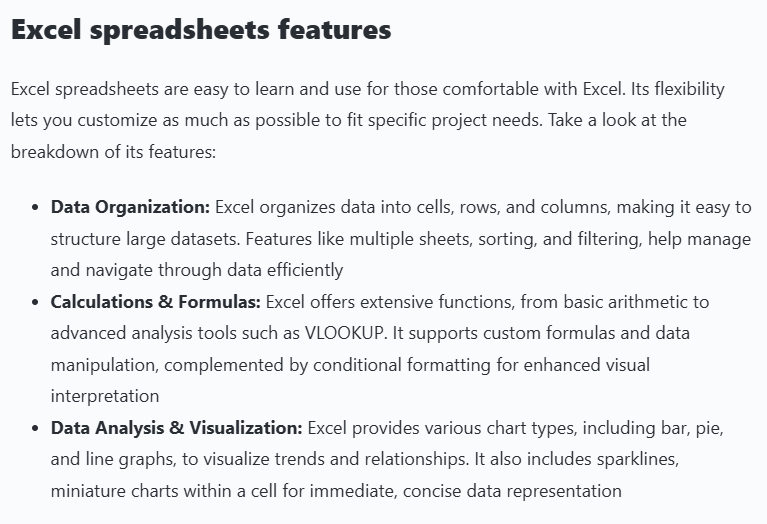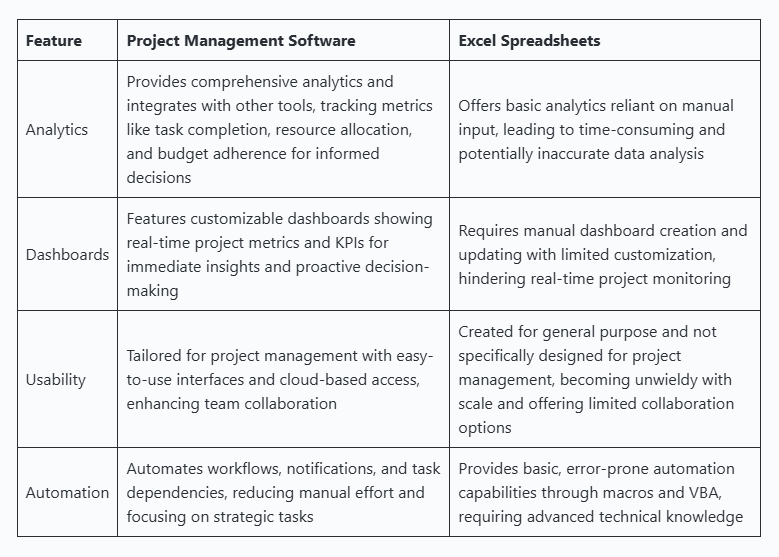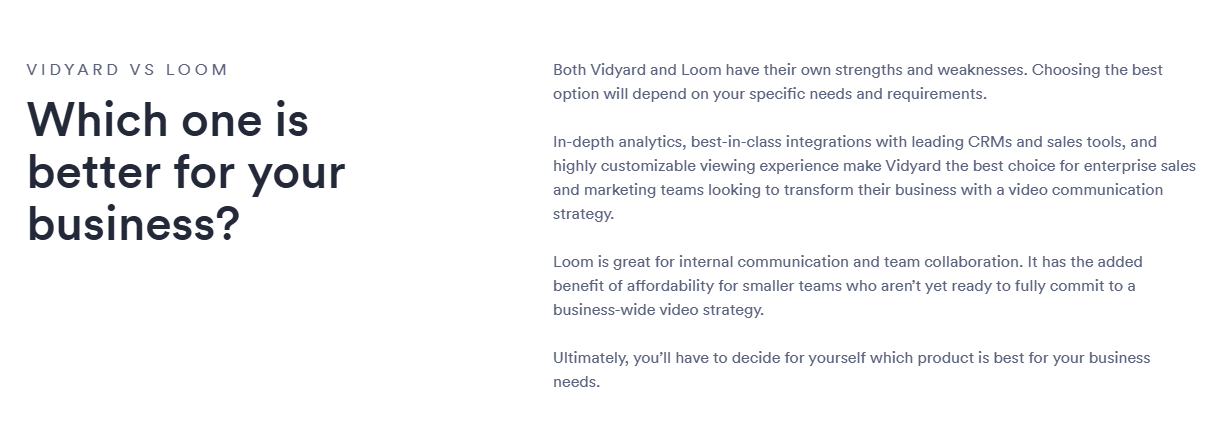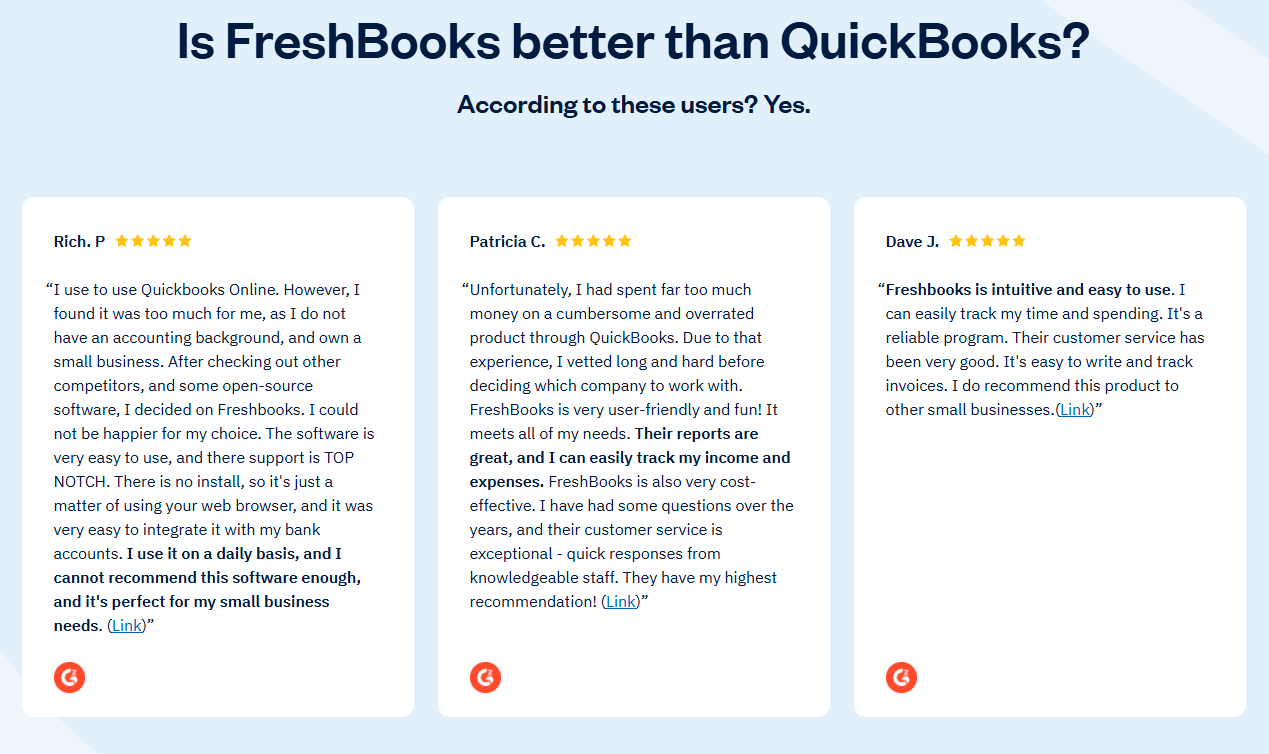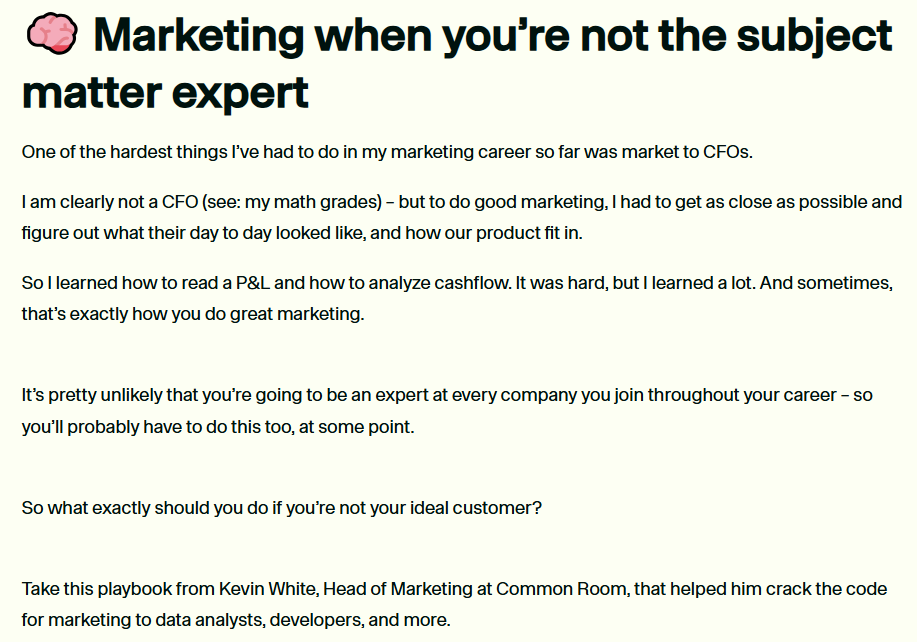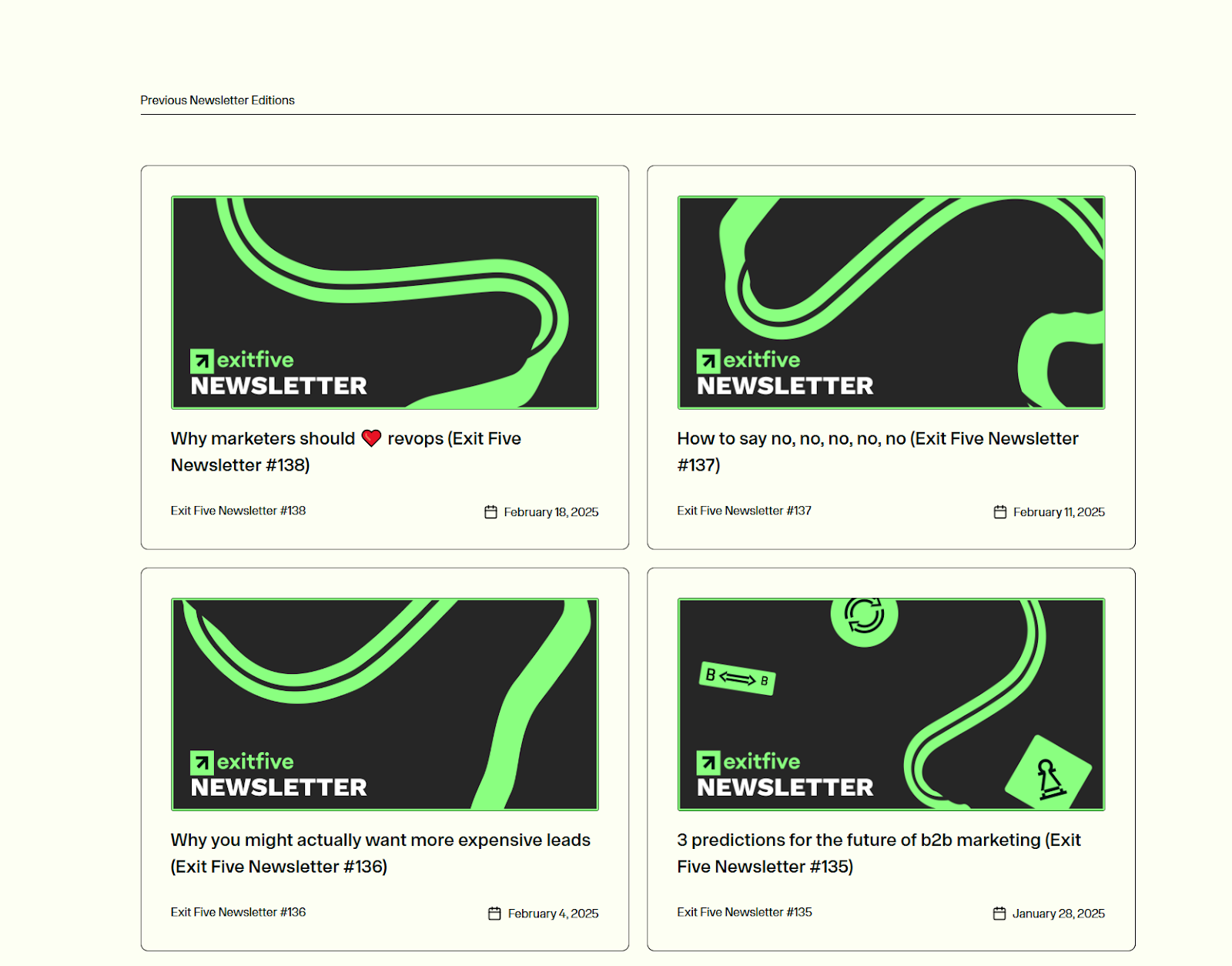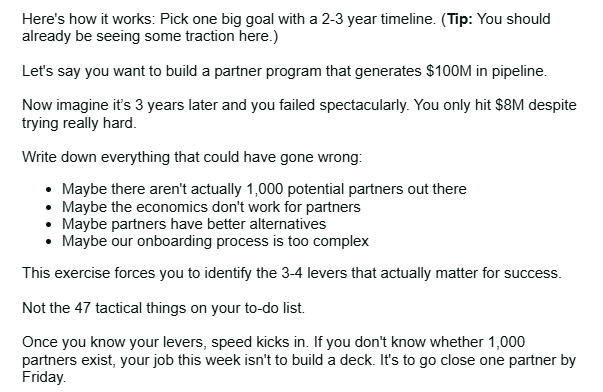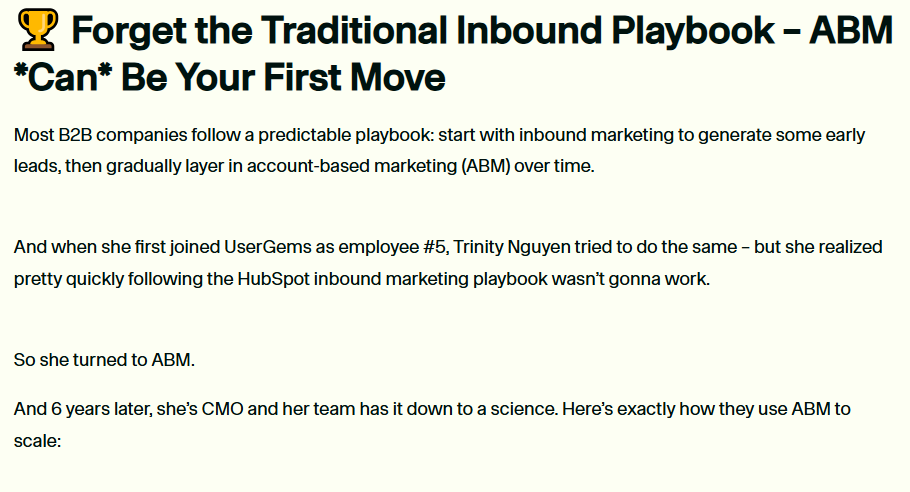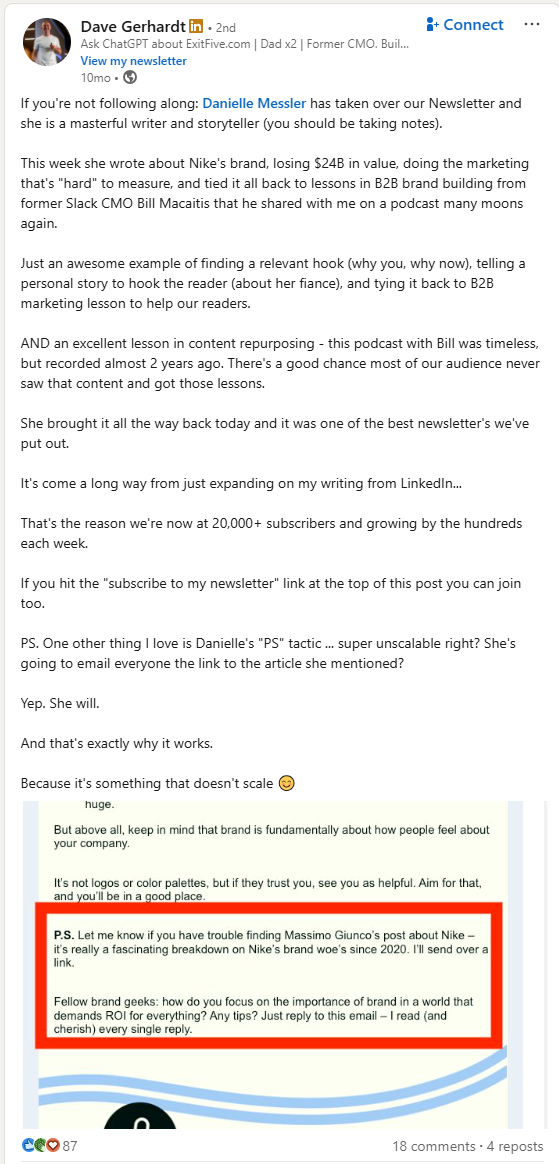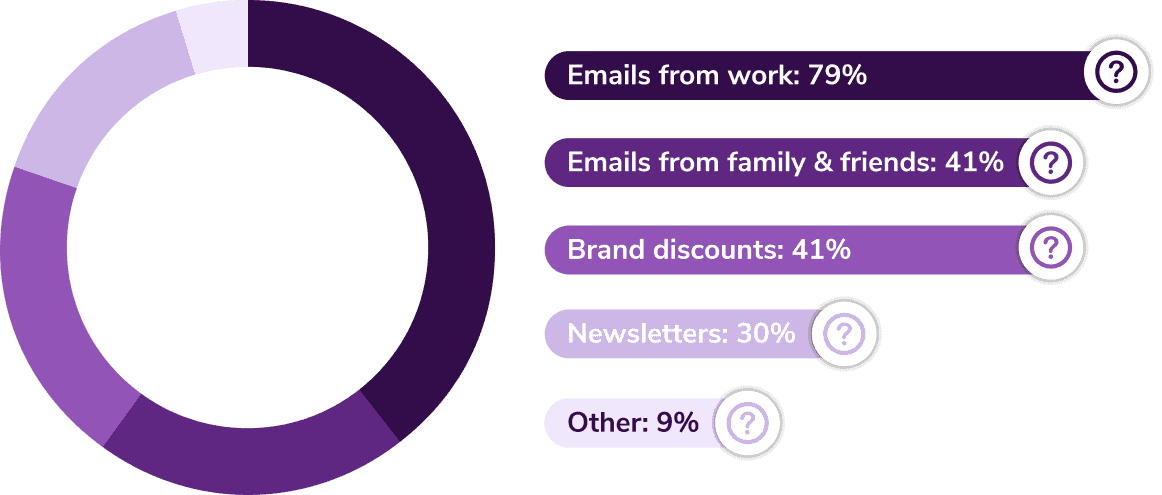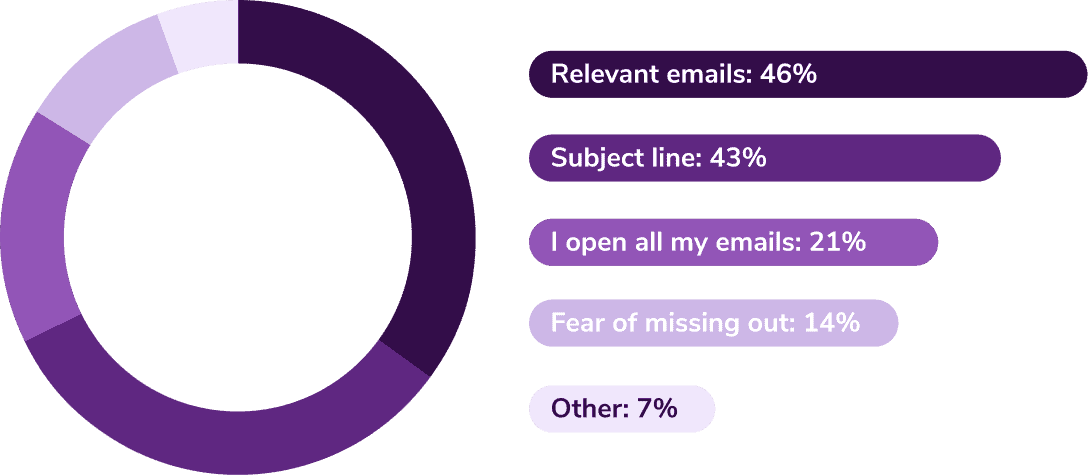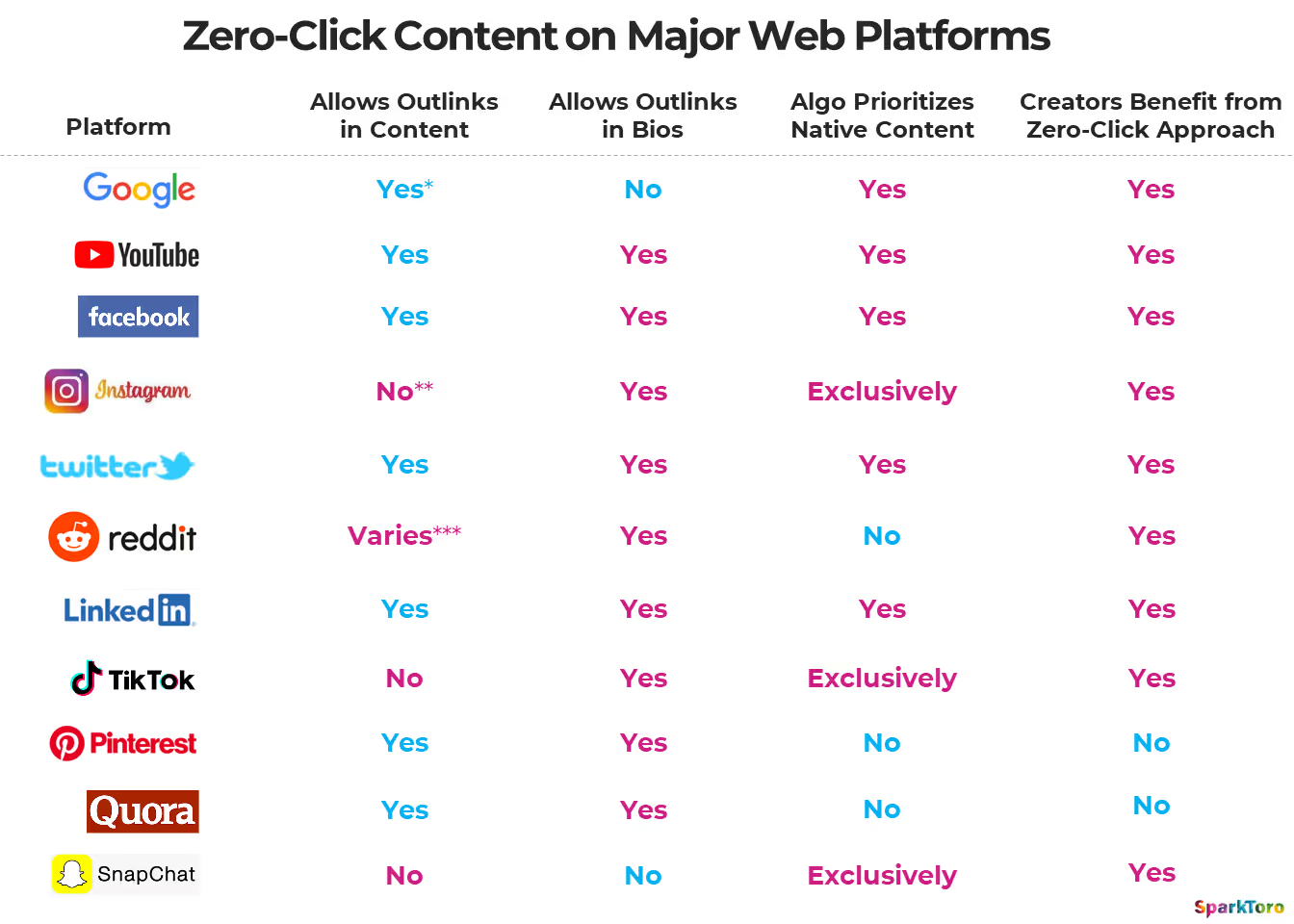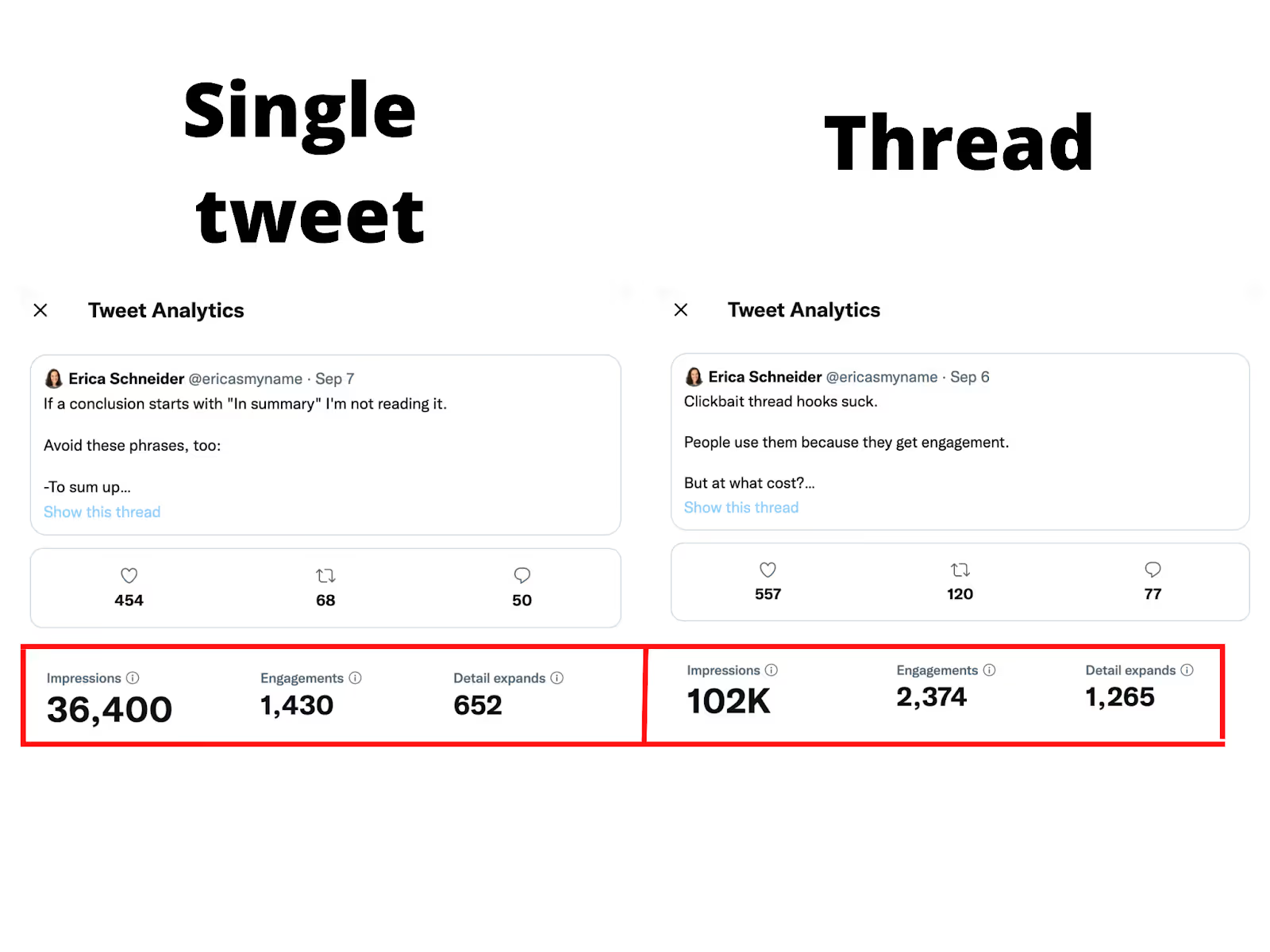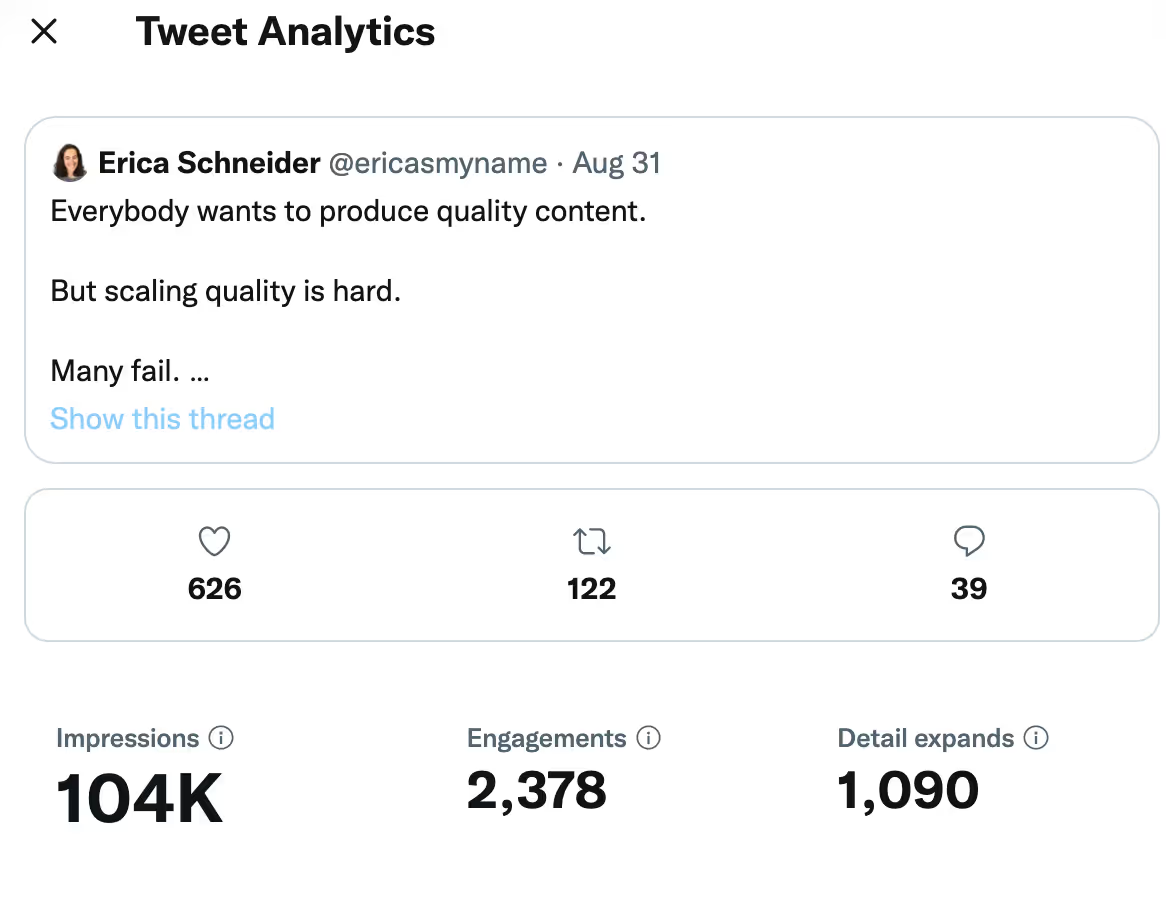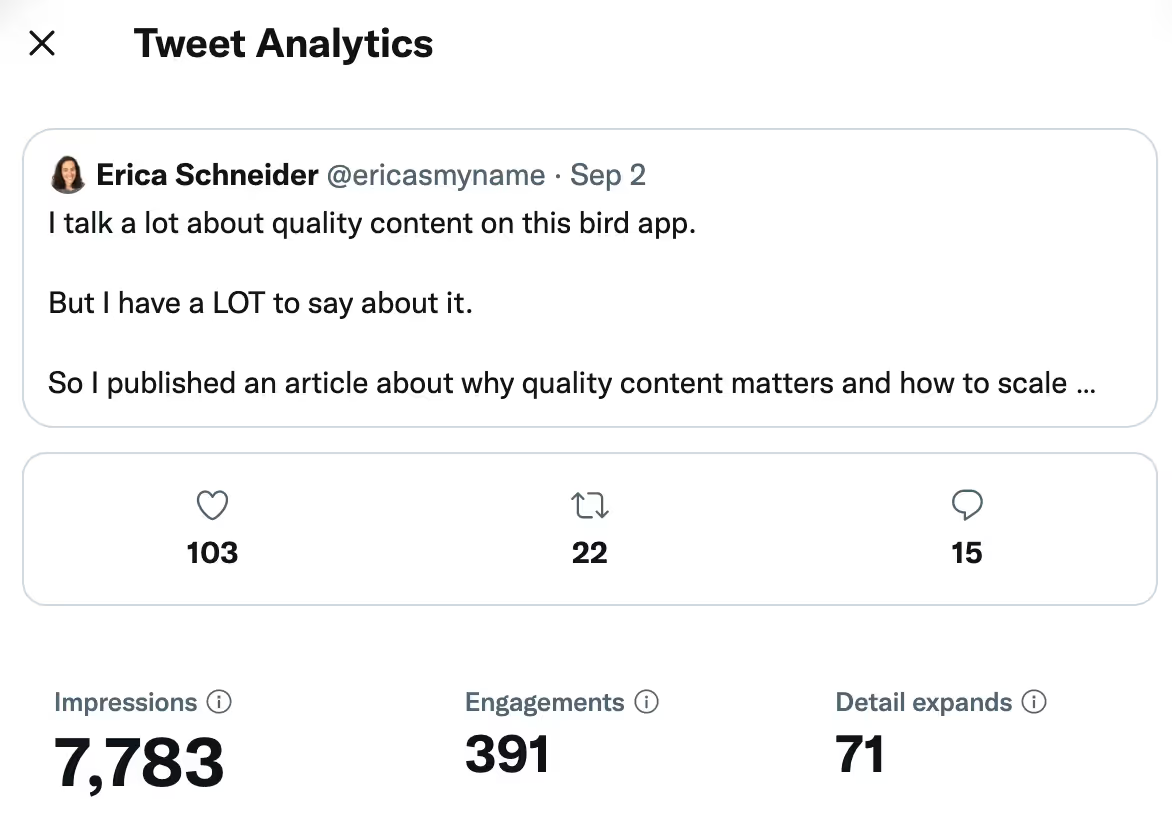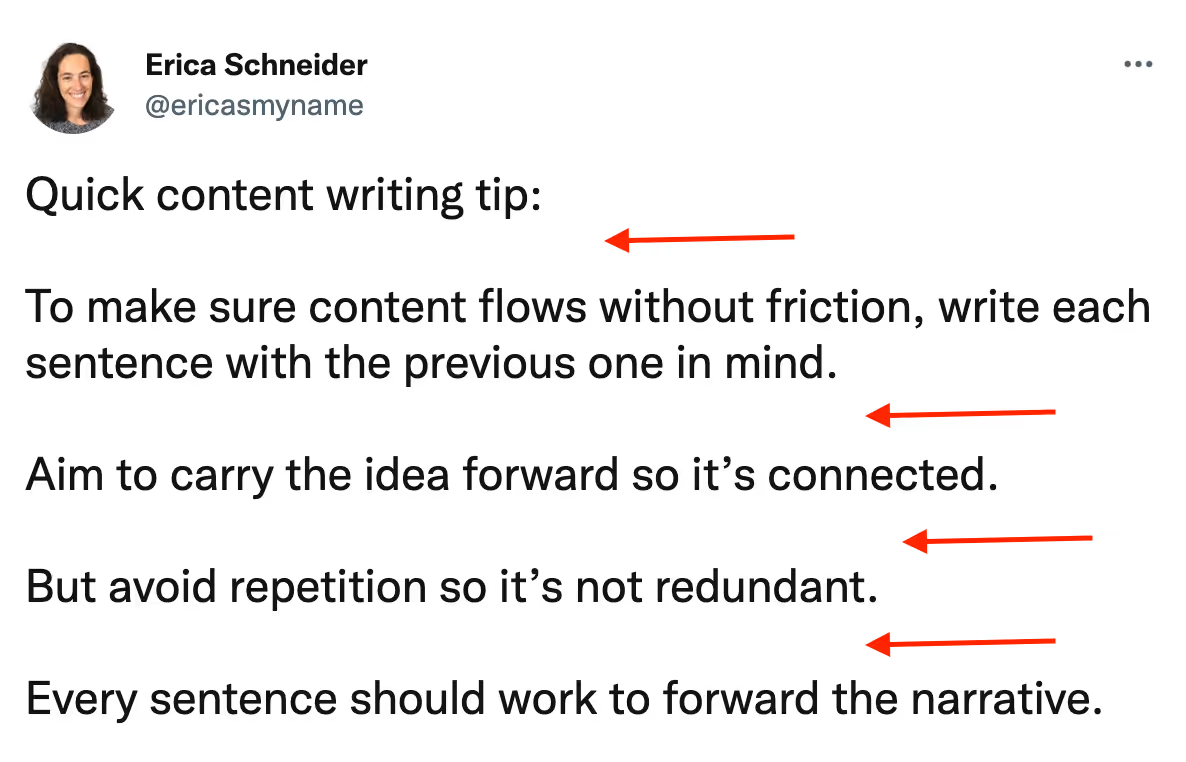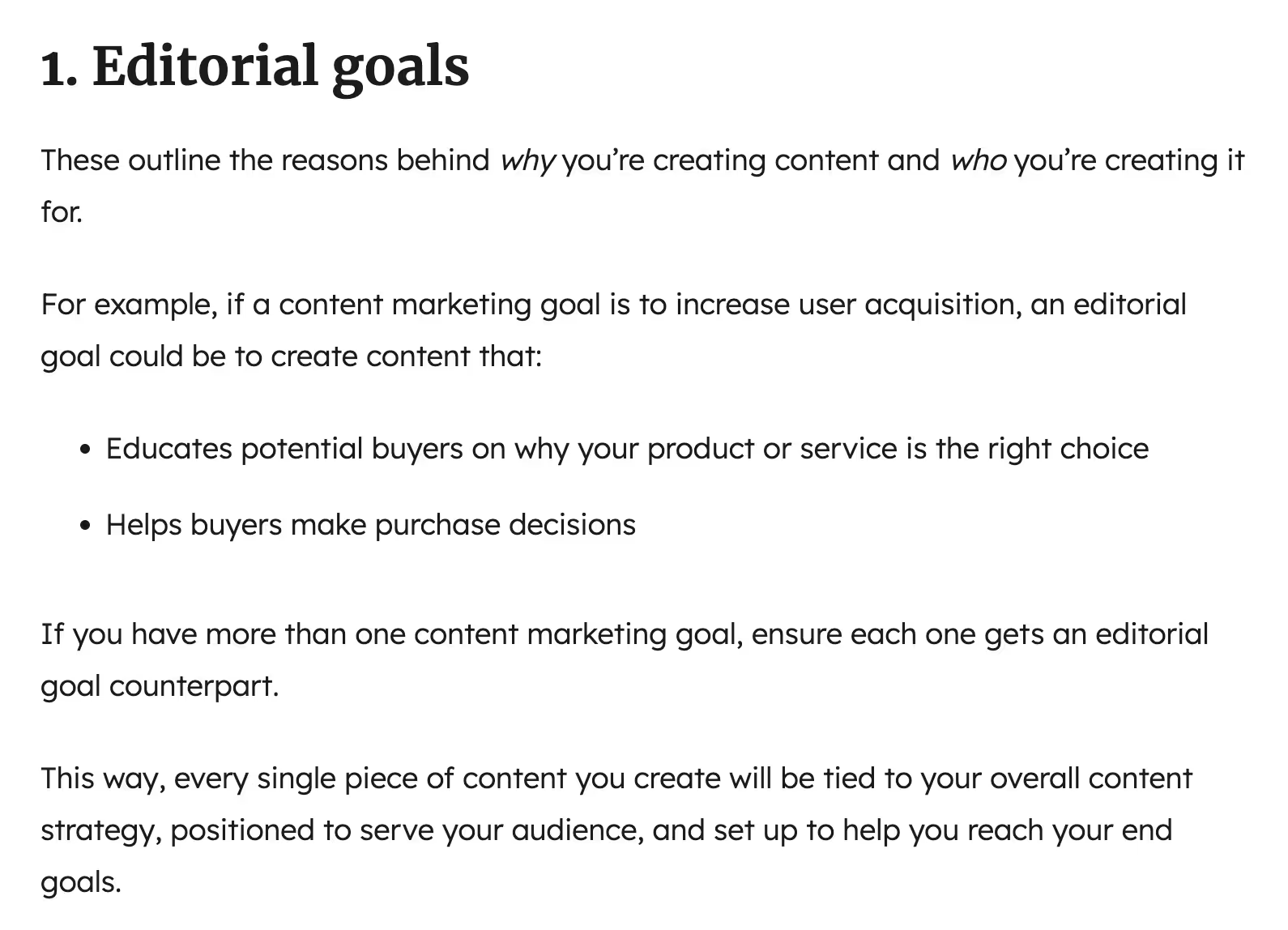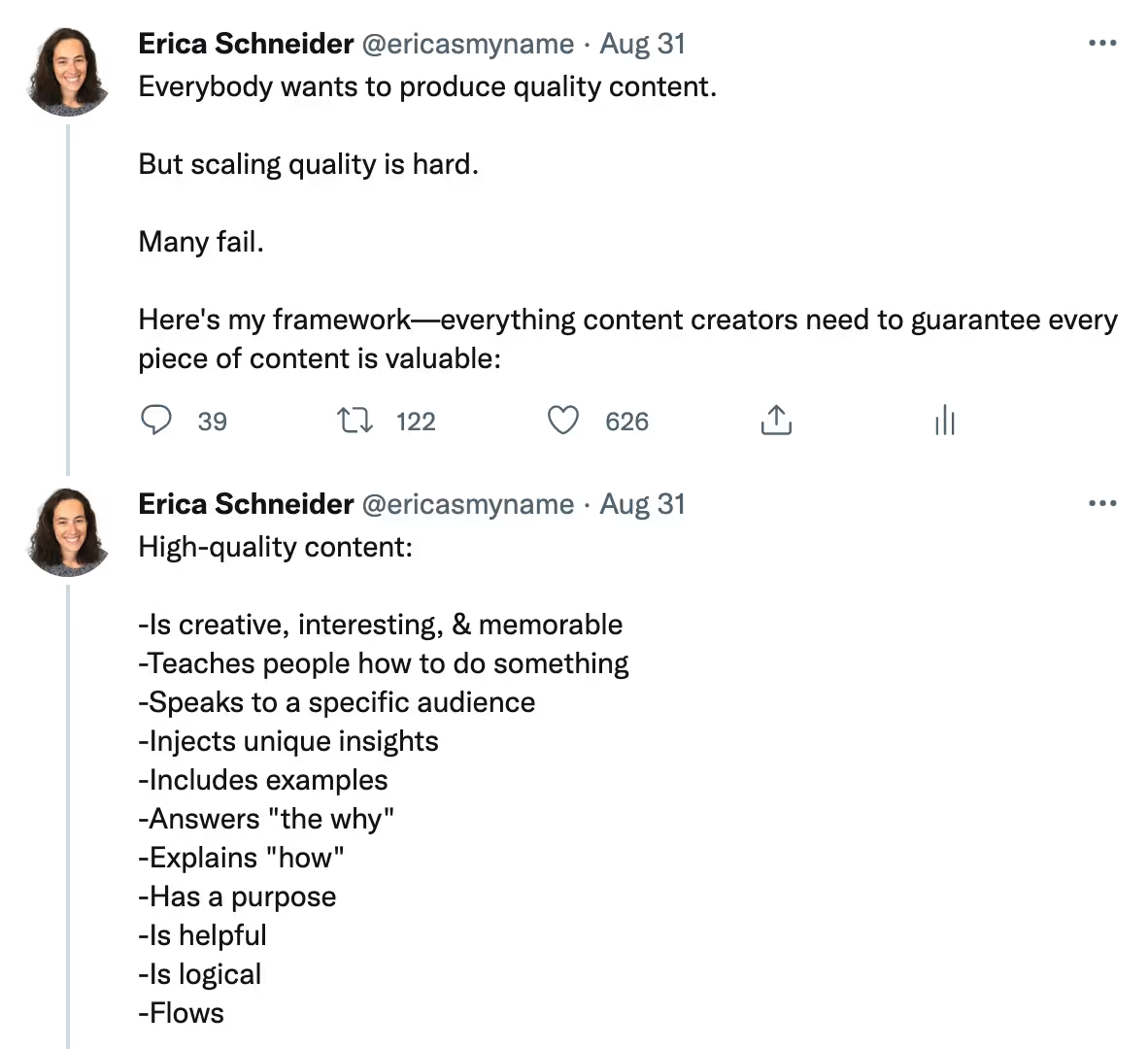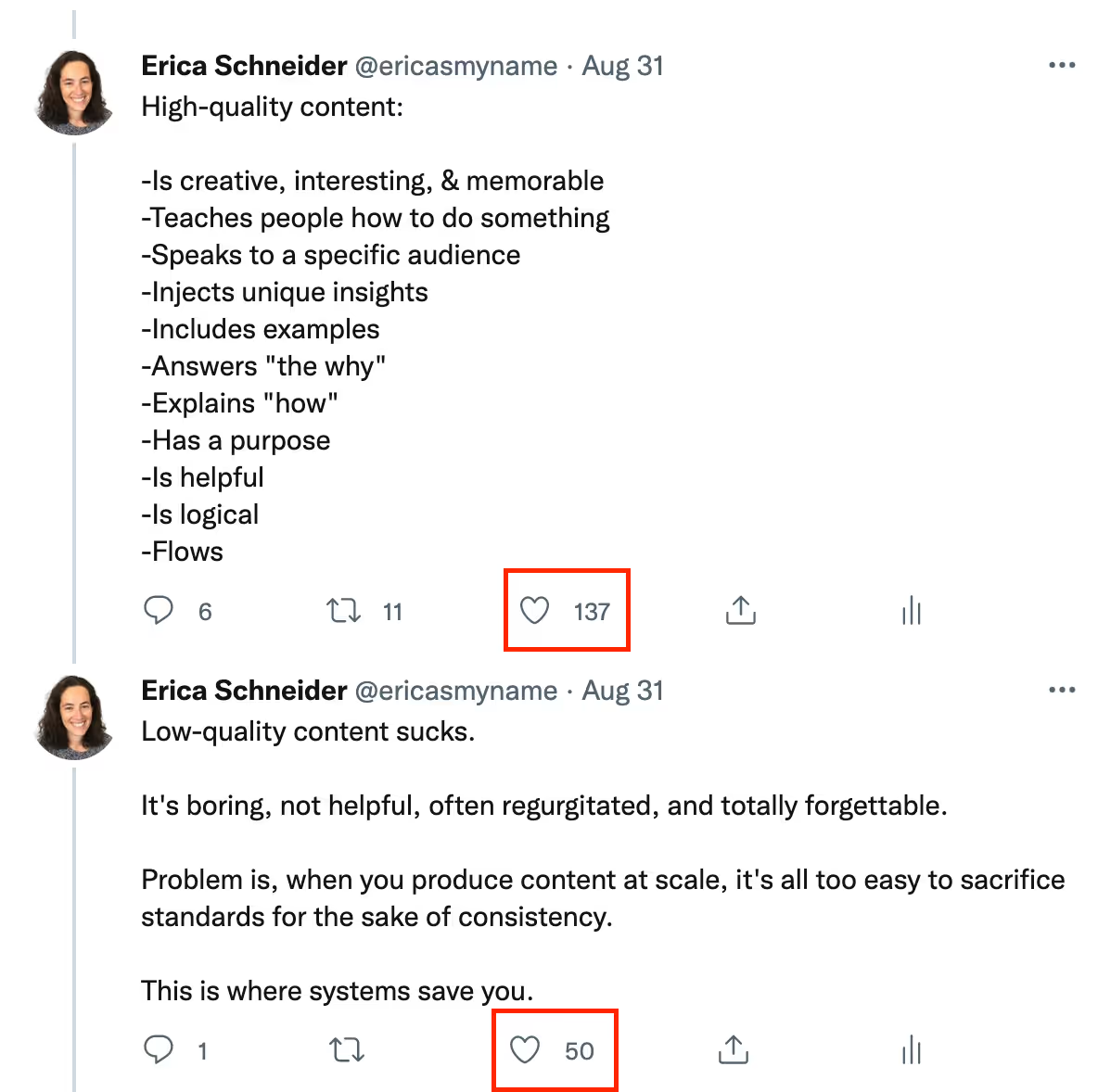In this in-depth guide, you’ll learn the process we use to help brands like Pipedrive and Tide improve content quality, boost search visibility, and drive more user sign-ups.
Content maintenance: Detecting decay and improving conversions
Content maintenance is the process of monitoring your content and improving it based on leading metrics. This could mean adding new sections, editing and expanding on existing content, making technical tweaks like adding internal links, or testing new calls-to-action.
Why is this an important part of any organic growth program? Over time, a blog post will hit a peak of traffic. It will then typically lose traffic (slowly or dramatically) as it becomes outdated or competitors enter the fray with more up-to-date information.
This is especially true in fast-moving industries like social media or finance. Here, we see that a particular article quickly ranked for a highly competitive keyword in the social media space:
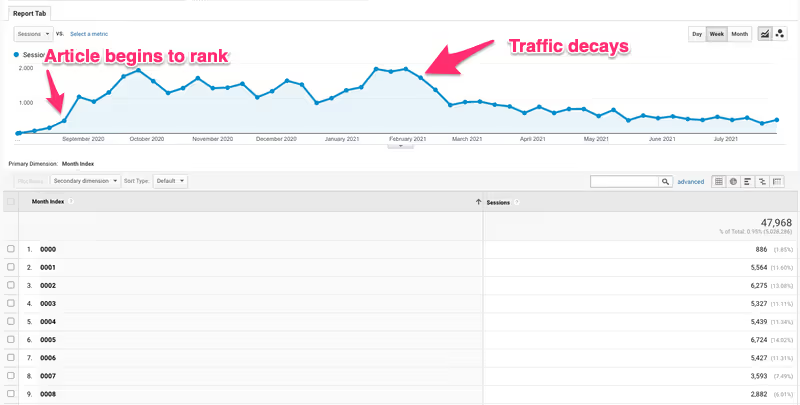
Due to the nature of the industry, other players create better content or update their existing guides to be more relevant. Slowly but surely, the article above was knocked from the top spot in Google.
Now imagine how this happens across an entire blog featuring hundreds of articles. Decay can add up to the tune of losing hundreds of thousands of unique monthly visitors.
So, how do we fix this problem?
Are you buying a car or investing in real estate?
Your blog acts as a portfolio of content and other digital assets. Much like brick-and-mortar investments become dilapidated through neglect, so does traffic and conversions that SEO-driven content generates.
Similarly, treat that same piece of content with care and respect, and you’ll see its value soar.
Content optimization systems don’t just protect you from traffic decay. They help you identify issues before they happen and take proactive steps to fix them. Similarly, they help you identify new and lucrative SEO opportunities.
For example, we helped a martech brand develop an aggressive SEO-driven content strategy to rank for highly competitive keywords in the paid media space.
Our goal was to solve their audience’s specific pain-points to demonstrate they’re the best solution for them while generating relevant search traffic.
One particular project was a “wiki” style guide, providing advanced information that provided readers with huge amounts of value.
We quickly captured the #1 spot in Google for our primary keyword, but over time ranked for the parent term. This presented an opportunity to increase traffic without creating a new piece of content.
We ran the article through our content optimization and refresh process and, in just 30 days, we increased search traffic to this single article by 301%:
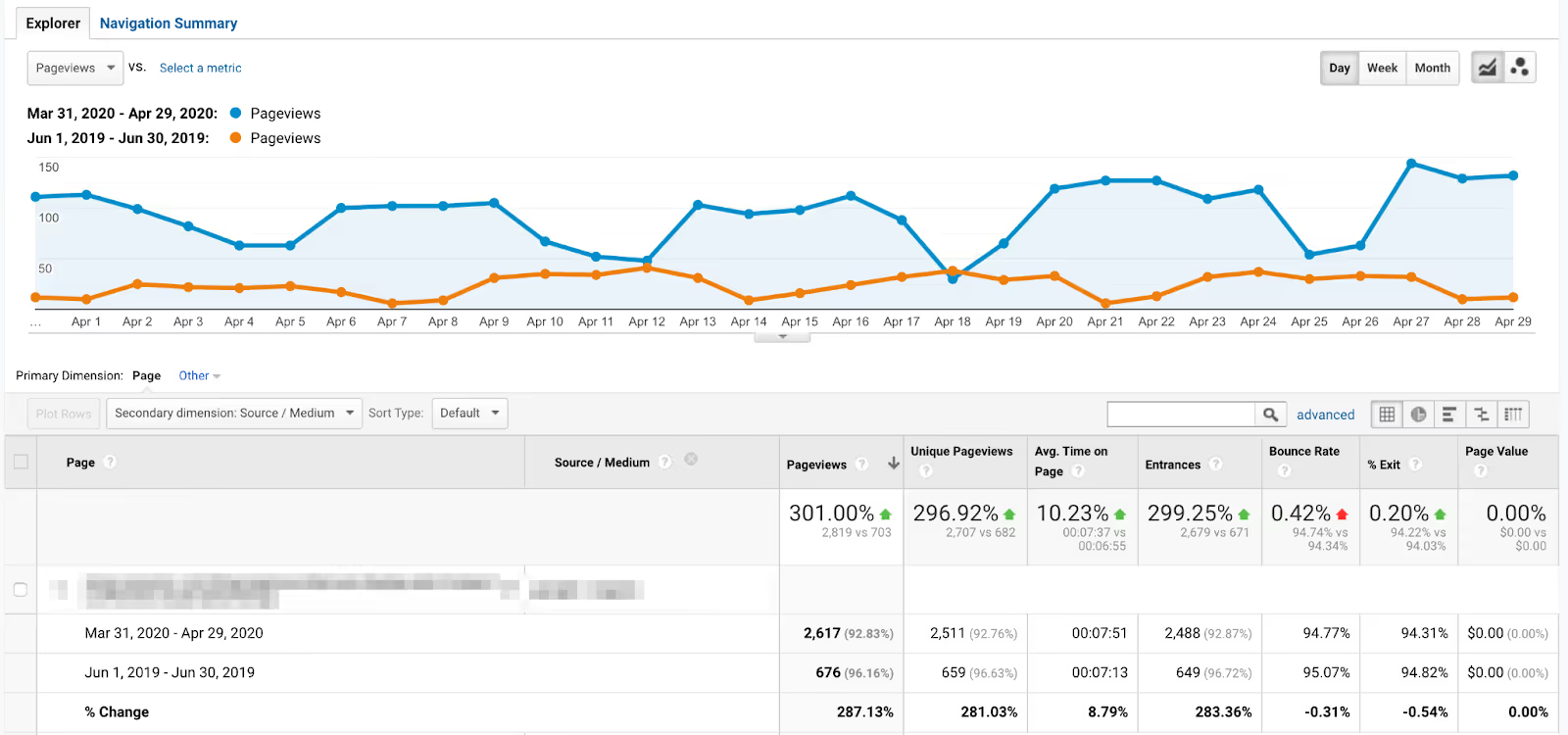
The two processes that made this possible are:
- Content audits to measure the right metrics in a proactive way
- A content refresh and optimization process that puts data and audience needs first
Most marketers run quarterly or annual content audits. By the time problems or opportunities are identified, the competition already has a leg up. The longer you leave it, the harder it is to fix issues and capture new opportunities.
Instead, consider auditing your content weekly or monthly depending on the size of your content portfolio (i.e. the number of blog articles, landing pages etc. you have).
Similarly, a content refresh is more than simply adding the right phrases and terms to make content more relevant. It must fill newly identified gaps and overdeliver on value in a way that nobody else can.
To overcome these challenges, we developed the following content optimization process:
- Collect the right data
- Use a content audit tool to wrangle data and identify issues and opportunities
- Prioritize content optimization projects based on a) severity of issues or b) how lucrative each opportunity is
- Optimize each stage of the content journey (from SERPs to introduction to call-to-action)
- Track and monitor changes to pivot where necessary
The rest of this guide will cover these steps in detail.
1. Identify issues and opportunities with a content audit
The first step is to identify, wrangle, and benchmark the right data to identify issues and new organic growth opportunities.
A content audit that measures the entire content journey is key, which looks something like this:

Here’s how to build a content audit tool step-by-step:
Collecting content performance data
Collecting content performance data only requires a handful of tools:
- Ahrefs/Semrush
- Google Analytics
- Google Search Console
- ScreamingFrog
- HotJar
Metrics are selected based on the reports needed to monitor each stage of the journey. For example, at Grizzle, we’d use data from a tool like Semrush to collect the following KPIs:
- Organic keywords that are being ranked across the entire site
- Specific keywords we’ve developed our content around
- Distribution and backlink performance
Similarly, you need engagement data, organic performance across each article, and conversions from Google Analytics.
Each of these data sources have their own sheet in the content audit, which looks like this:

Monitoring each stage of the content journey
Every interaction across that content journey can be measured. These interactions each play a part in the overall performance of your content.
Bring these metrics into a single view or sheet in this case to get a high-level overview of how content is performing across the entire journey. We call this the “Content Analysis” view, and is broken down by the following content journey stages:
SERP Performance
- Clicks
- Impressions
- CTR
- Avg. position
SEO Performance
- Top Keyword
- Volume
- Keyword Difficulty
- Current Position
- Internal Links
Content Performance
- Pageviews
- Avg. Time on Page
- Bounce Rate
- Conversions
- CR%
Distribution
- Organic Traffic
- Referring Domains
- URL Rating
- Dofollow
- Nofollow
Digging into SERP performance, you can see a “red amber green” (RAG) system under the CTR column:
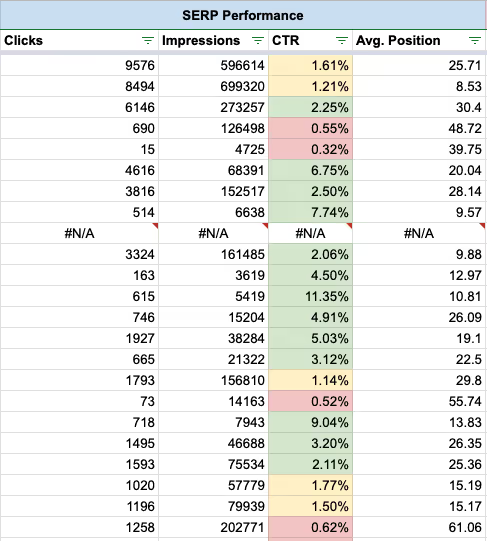
- Green means we’re hitting an adequate CTR from the SERPs. A healthy number of people are clicking through to our content when they search for something in Google.
- Yellow means things are “ok”, while red is a problem. As you can see, anything below a 1% CTR is cause for concern.
For SERP performance, CTR is our leading performance indicator. For SEO performance, there are two:
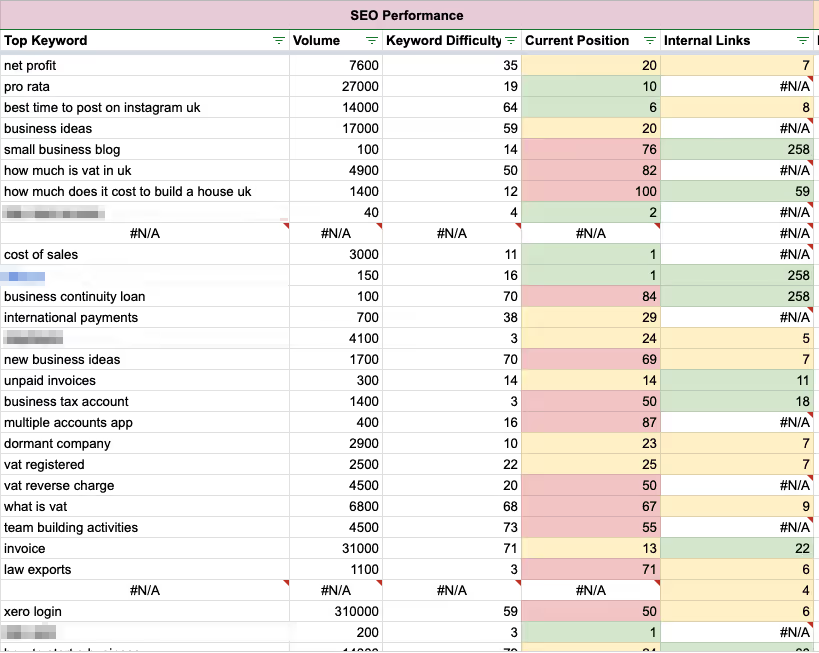
- Current position: Where content ranks for your “top keyword”?
- Internal links: How many internal links are pointing to this content from across the site
Note that “top keyword” is different to “primary target keyword:”
- Primary target keyword is what an article was originally written to rank for
- Top keyword is the keyword that the article ranks for with the highest search volume (no matter what position it’s in)
For example, in the report above, you can see that the top keyword for the first row is “net profit,” which has a search volume of 7,600. However, the primary keyword is “net profit margin”, which generates 2,600 searches a month.
Our content ranks for both, but the “top keyword” is not one we deliberately aimed to capture. We can use this insight to optimize content for broader keywords, increase search visibility, and capture more organic traffic.
This content audit may look overwhelming. For us, it started as a series of IF statements, VLOOKUPs, and conditional formatting. Start here and build out more sophisticated reporting as your systems evolve.
Once you’re monitoring opportunities and issues, it’s time to start fixing them.
2. Increase CTR and SERP performance
Why do people click on one search result over another?
Usually, it’s because the metadata aligns with what they’re searching for and communicates the benefits of the content.
This means your best bet of increasing CTR is optimizing page titles and meta descriptions.
Let’s start with page titles. When you search for a keyword, you’re often met with a series of results that look awfully similar:
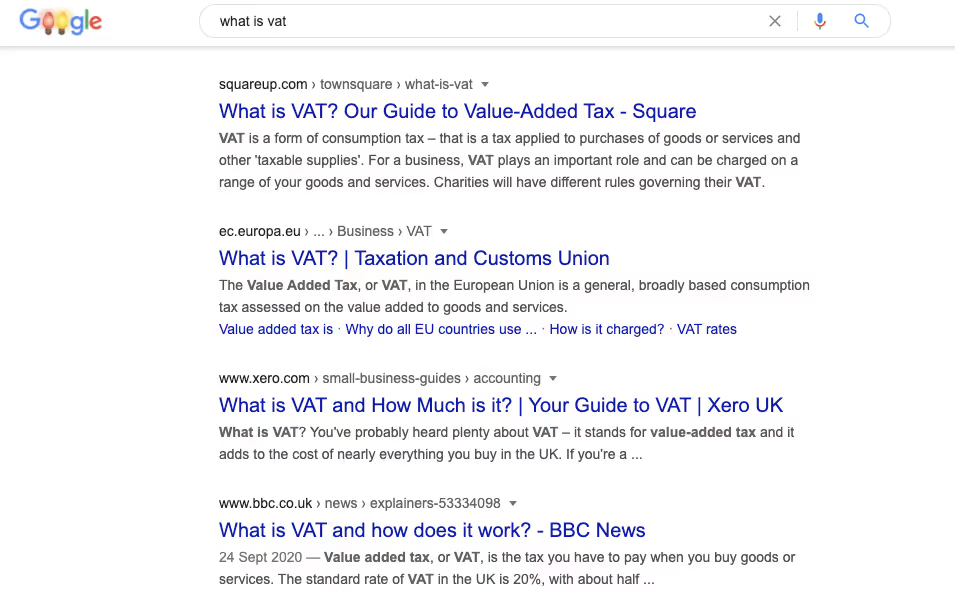
Luckily, Google has done a lot of the heavy lifting for us. These are the results that it deems most relevant based on user behavior. In other words, when a user clicks a result, it sends a signal to Google that their attention was captured when searching for a specific query.
The more people do that on a particular result, the more Google deems that page the most relevant result, and thus, it ranks higher.
While this is an important signal, most marketers use the SERPs as their single source of truth when researching elements of their content. They’ll simply emulate whatever they see on page one of Google and make a few subtle tweaks.
When writing page titles, a better approach is to emulate what Google is serving while using the language of your audience. This will not only let your content stand out, but show users that you understand their needs.
There are a handful of ways to do this:
- Speak to your customers and ask them questions related to the topic
- Ask questions in relevant communities
- Use audience intelligence and social listening tools
For example, following on from the “what is VAT” search in our screenshot above, we find the following relevant posts in Quora:
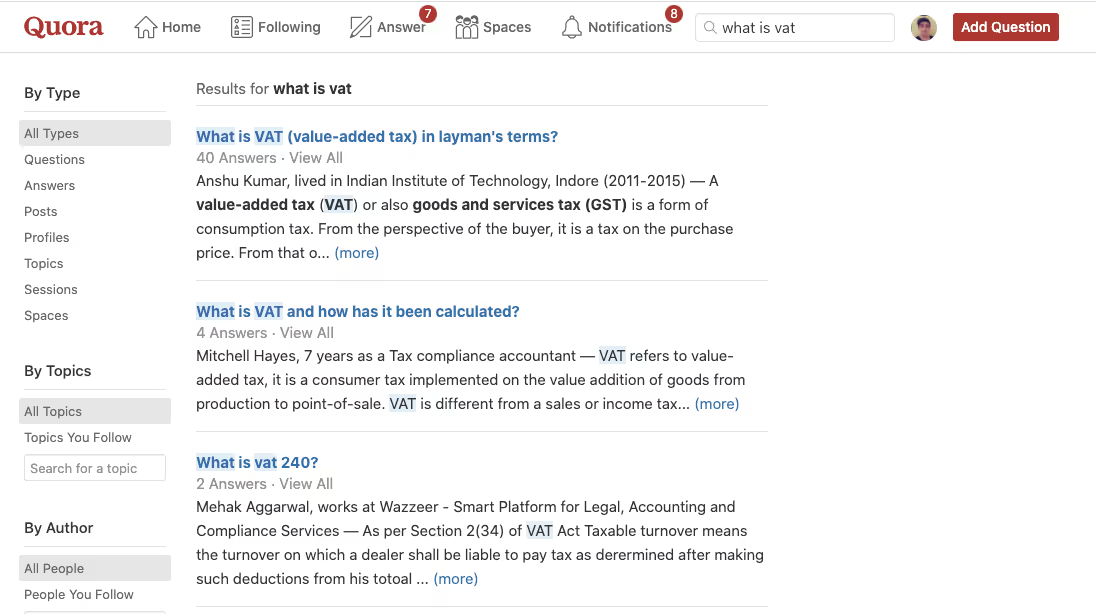
The most popular post asks for a definition in layman’s terms. Further research shows that our audience wants an easy-to-understand definition of what VAT is.
We can then take the language of this audience and use it in our page title:
“What is VAT? A Layman’s Guide to Value-Added Tax”
The same approach can be applied to the meta description:
“In this complete guide to VAT, you’ll learn how to calculate value-added tax and what it means for your business (current rate: 20%).”
Based on our topical research, we determined that the following elements are important to our audience and should be included in the article:
- A complete guide to VAT with everything they need to know
- How to calculate it
- Why it matters to their business in the first place
- What the current VAT rate is
We made sure our page title and meta description communicated these elements, first making sure that our content delivers on those promises.
Some of the pages on the SERPs do this, but few (if any) do all of them. This page title and description successfully ticks three boxes:
- We’re working to fulfill existing search intent
- We’re differentiating our content among a sea of “sameness”
- We’re talking the language of our audience
3. Improve internal linking across your content
Proper internal linking can have a huge impact on search engine rankings. For example, Ninja Outreach managed to increase organic traffic by 40% through a robust internal linking project:
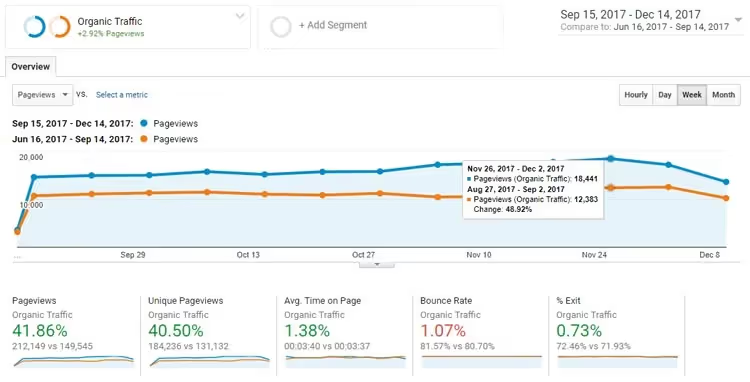
To find internal linking opportunities, simply group together pages of the same topic cluster and order them by page authority (PA) or URL rating (UR). Then, add internal links from relevant pages to the content you’re looking to optimize.
Alternatively, you can use the “Top pages” or “Best by links” reports in Ahrefs:
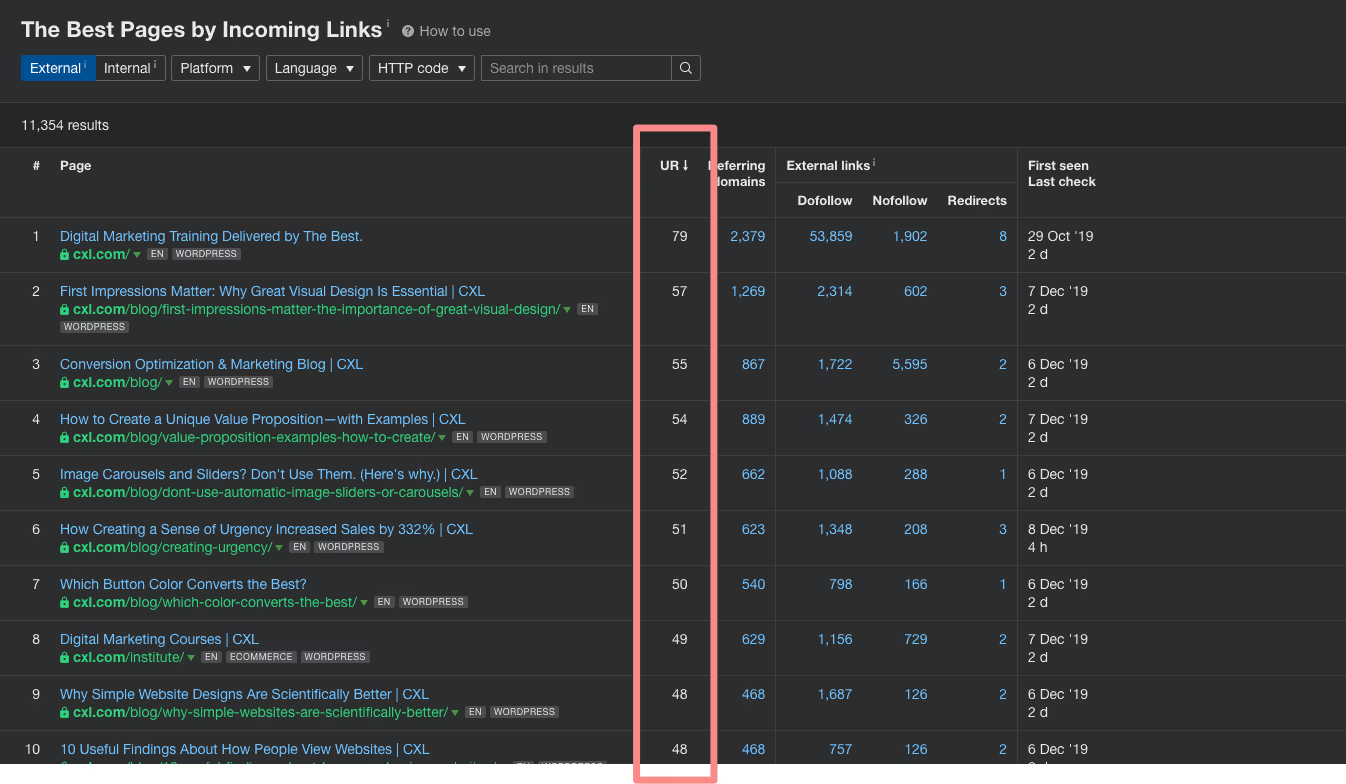
4. Refresh your content for higher search rankings
Content refreshing is the most powerful optimization tool at our disposal. Done right, you can see an increase in search rankings and conversions just by improving the quality, relevancy, and depth of your content.
There are over a dozen techniques we use to optimize and refresh content. However, the levers that make the biggest impact are:
- Using data-driven tools like Clearscope to improve relevancy and inject important themes
- Improving quality, information gain, and offering a unique angle
Clearscope is a foundational tool for making sure content is relevant. It collects data from IBM Watson and Google Graph Map to determine which themes Google deems most important for a primary target keyword.
Research by Backlinko found that “content with a high ‘Content Grade’ (via Clearscope), significantly outperformed content that didn’t cover a topic in-depth:”

But you can’t simply stuff new terms in your content and expect to see improvements. Instead, use these terms as a litmus for what you should include or expand on in your content. Give readers everything they need to understand and act on the advice you’re providing them.
Take the following subsection for an article on “self assessment statements” in UK:
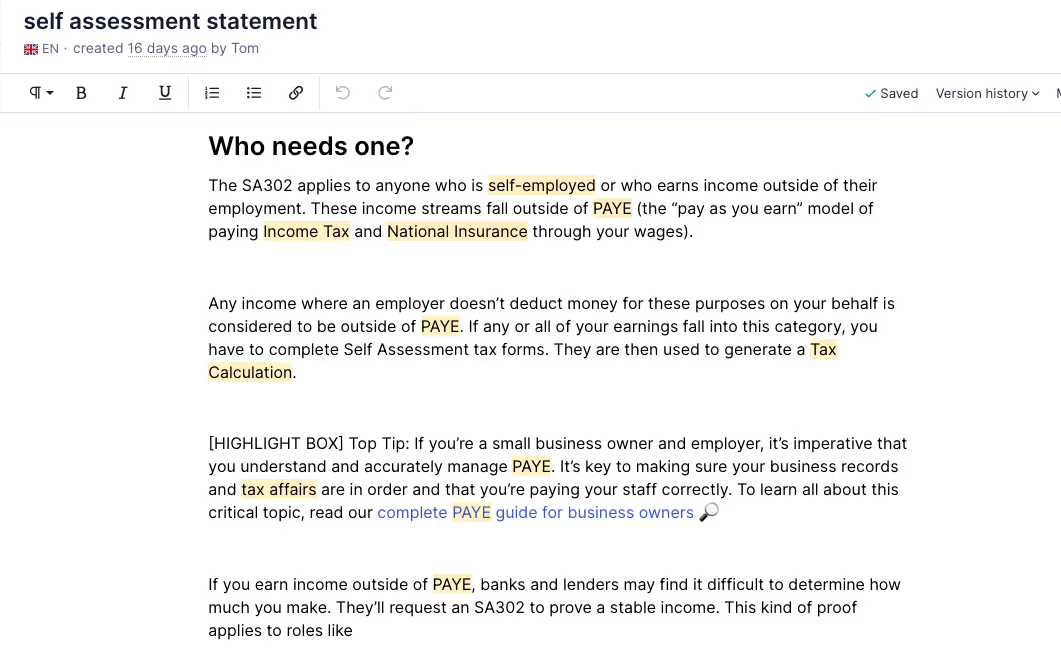
The highlighted text is what Clearscope deems “important” from an SEO perspective. The following appear in the subsection:
- Self-employed
- PAYE
- Income tax
- National insurance
- PAY
- Tax calculation
- Tax affairs
These terms aren’t “stuffed” into the content carelessly. They add context and value, building a detailed narrative and answering the question; “who needs a self assessment statement?”
When using data-driven tools, ask yourself why a term should be added. Does it need its own subsection to allow for a large enough canvas that explores the topic in as much depth as possible?
Don’t forget to expand on threads. These threads include the topics, ideas, and themes that are presented in the content that needs additional depth.
Close the loops started in your threads by including:
- Examples
- Detailed explanations
- Stats and data
- Actionable takeaways
These elements give your readers everything they need to take action. It also makes sure your content is comprehensive, which strengthens your moat and makes it harder for competitors to outperform you.
5. Boost content engagement by keeping your readers hooked
Low avg. time on page, bounce rates, and even low scroll depth (measured using scroll maps) happen when content fails to:
- Quickly hook the reader in
- Keep them engaged and excited throughout the content
- Deliver on enough value to instill a feeling of empowerment
Most people don’t have low attention spans, they have low consideration spans. You only have a few seconds to capture that attention by proving you have what a reader (or searcher) is looking for. Introductions that pique interest or make a bold promise are key. As are value-driven subheadings.
For example, in CXL’s article on app store optimization (ASO), the first section gives a high-level overview of what ASO is and why it’s important:

We could have just written “What is ASO?” Instead, the subheading communicates the specific outcomes that CXL’s audience of seasoned marketers are yearning for.
Once you have their attention, you must keep them hooked. This means communicating in a clear manner while overdelivering on the value you’ve promised.
Filler and fluff is your worst enemy. Every unnecessary word creates friction that prevents your reader from gliding through your content.
For example, here’s a subsection taken from another article from CXL on storytelling:
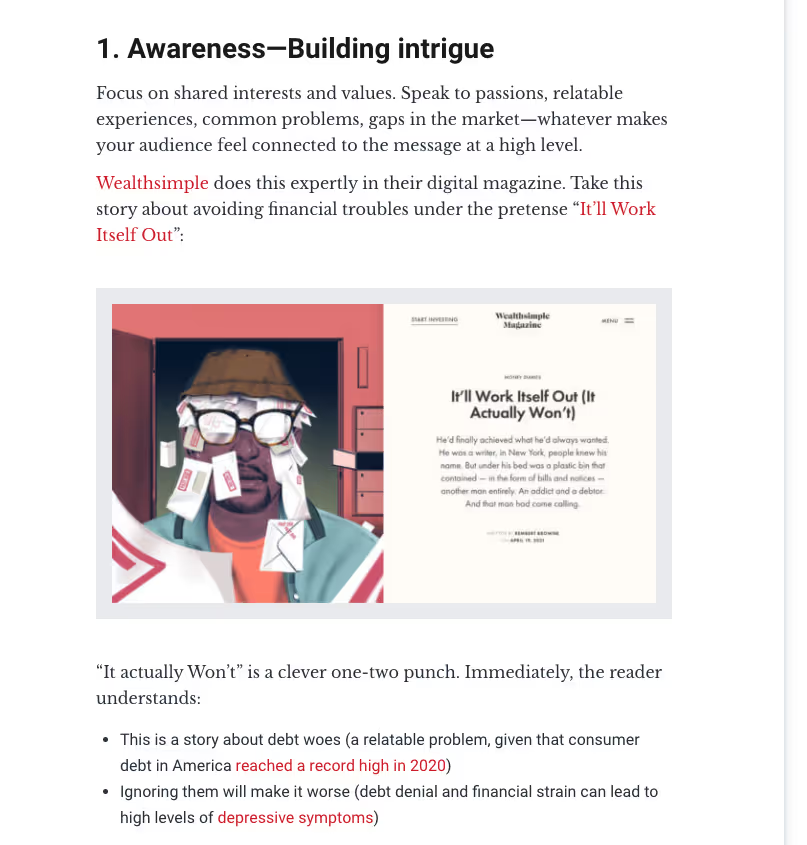
Let’s break this subsection down paragraph by paragraph:
Focus on shared interests and values. Speak to passions, relatable experiences, common problems, gaps in the market—whatever makes your audience feel connected to the message at a high level.
The first sentence of this subsection provides value in no more than six words. It continues by offering how to build intrigue (passions, experiences) and communicates why it’s important (it makes your audience feel connected).
Wealthsimple does this expertly in their digital magazine. Take this story about avoiding financial troubles under the pretense “It’ll Work Itself Out”:
We're then introduced to an example and supporting imagery of this principle in action. This makes our content easier to digest.
“It Actually Won’t” is a clever one-two punch. Immediately, the reader understands:
* This is a story about debt woes (a relatable problem, given that consumer debt in America reached a record high in 2020)
* Ignoring them will make it worse (debt denial and financial strain can lead to high levels of depressive symptoms)
80% of Wealthsimple’s clients are under 45. Because the familiar story is told by a peer and not a faceless brand, it works to build authority.
Here, a perspective of the example is shared, along with two clever components and an analysis on why they’re effective. We're not leaving the reader to connect the dots themselves, we're doing it for them.
Many readers see themselves in this story. Living paycheck to paycheck, even with a good job, saddled by debt, and paralyzed by calls from debt collectors.
This paragraph brings it back to the topic at hand. At the beginning of the subsection we talk about the importance of shared interests, values, and experiences. The way Wealthsimple does this is by sharing customer stories, which delivers a takeaway from the example.
The story pulls the reader in and incites a desire to learn more. What does this company have to offer me? Have they solved the author’s problems?
The section is then concluded while acting as a “bridge” to the next. We’re left wondering, “what’s next?” The answer is in the next section.
In just 190 words, this section provides the following "aha!" moments:
- The "ingredients" we need to build intrigue (values, experiences, etc.)
- Why those ingredients are important (to make the audience feel connected)
- An example of a brand that does this well (illustrating the lesson)
- A breakdown of why the example works so well (debt and financial strain is the shared experience of their audience)
- An additional outcome of this story (Wealthsimple builds authority)
- How this looks from the eyes of Wealthsimples's audience (they see themselves, trying to overcome debt)
- What I can do with this information (build intrigue to pull readers in and entice them to learn more)
As well as an easy reading experience, you must continuously teach users something new. Provide “aha!” moments as often as possible; either by presenting a new idea or reinforcing those ideas with examples, takeaways, and instructions on executing them.
At Grizzle, we call this “Aha! Velocity.” It’s the speed at which new information is shared or the rate at which readers connect the dots between existing ideas.
Increase your “Aha! Velocity,” make your content easy to read, and you’ll have high-performing content that people will read from start to finish.
6. Optimize conversions by testing new CTAs and offers
There’s no point in creating content that people love if it doesn’t contribute to your acquisition, retention, or demand generation efforts.
Low conversion rates from content usually occurs due to a misalignment between the offer and where in the journey your readers are at.
For example, if a user wants to learn the basics of “digital transformation,” it’s unlikely they’ll be interested in a service that does it for them (yet).
Instead, offer them templates, cheat sheets, and resources to make a case with their bosses. Build and nurture an audience and convert them into customers or users when the time is right.
For example, Pipedrive heavily invests in top-of-funnel content as part of an aggressive SEO strategy:

Here, they offer a relevant resource to help readers solve a job-to-be-done (JTBD) presented in the article. Pipedrive could have offered a free trial of their CRM, but understand the value in audience building and serving readers first.
On the flip side, someone looking for an alternative to HubSpot is probably ready to test out a new CRM.
Content should generate ROI. But not at the expense of audience building and brand equity.
Start a relationship with your users. Use your email marketing, social media, and retargeting capabilities to strengthen those connections by nurturing and educating them over time.
Strengthen your content portfolio
For those who have never optimized or refreshed their content, the first step is to conduct an in-depth content audit like the one presented in this guide.
Measure each stage of the content journey to identify issues that need fixing. Improve your CTR, refresh your content to make it more relevant, and you’ll begin to see your organic traffic soar.
[[component]]
The processes outlined in this article is the exact methodology we use to help our SaaS clients refresh and optimize their content.
Want to learn more? Sign up for a consultation to get a free content audit.












